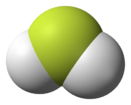Chemistry:Fluoronium

| |||
|
| |||
| Names | |||
|---|---|---|---|
| IUPAC name
Fluoronium
| |||
| Systematic IUPAC name
Fluoranium | |||
| Identifiers | |||
3D model (JSmol)
|
|||
| ChEBI | |||
| ChemSpider | |||
| |||
| |||
| Properties | |||
| H2F+ | |||
| Molar mass | 21.01374 g mol−1 | ||
| Conjugate base | Hydrogen fluoride | ||
Except where otherwise noted, data are given for materials in their standard state (at 25 °C [77 °F], 100 kPa). | |||
| Infobox references | |||
The fluoronium ion is an inorganic cation with the chemical formula H2F+. It is one of the cations found in fluoroantimonic acid.[1] The structure of the salt with the Sb2F−11 anion, has been determined.[2][3] The fluoronium ion is isoelectronic with the water molecule and the azanide ion.
The term can also refer to organyl substituted species of type H––R, R––R, or R2C=F+. In contrast to the heavier halogens, which have long been known to form open-chain halonium ions (such as [Me2Cl]+[Al(OTeF5)4]–)[4] as well as cyclic haliranium ions, fluorine was not believed to form fluoronium ions of type R––R until the recent characterization of a fluoronium ion locked in a designed cage structure by Lectka and coworkers.[5] Recent solvolysis experiments and NMR spectroscopic studies on a metastable [C–F–C]+ fluoronium ion strongly support the dicoordinated fluoronium structure over the alternative rapidly equilibrating classical carbocation. Definitive structural proof of the symmetrical [C–F–C]+ was reported by Riedel, Lectka, and coworkers by single crystal X-ray diffraction analysis. Besides its synthesis and crystallographic characterization as the [Sb2F11]− salt, vibrational spectra could be recorded and a detailed analysis concerning the nature of the bonding situation in this fluoronium ion and its heavier halonium homologues was reported.[6]
References
- ↑ Esteves, Pierre M.; Ramírez-Solís, Alejandro; Mota, Claudio J. A. (March 2002). "The Nature of Superacid Electrophilic Species in HF/SbF5: A Density Functional Theory Study". Journal of the American Chemical Society 124 (11): 2672–2677. doi:10.1021/ja011151k. ISSN 0002-7863. PMID 11890818.
- ↑ Mootz, Dietrich; Bartmann, Klemens (1988). "The Fluoronium Ions H2F+ and H3F+2: Characterization by Crystal Structure Analysis". Angewandte Chemie 27 (3): 391–392. doi:10.1002/anie.198803911.
- ↑ Diercksen, G. H. F.; von Niessen, W.; Kraemer, W. P. (1973). "SCF LCGO MO studies on the fluoronium ion FH+2 and its hydrogen bonding interaction with hydrogen fluoride FH". Theoretical Chemistry Accounts: Theory, Computation, and Modeling 31 (3): 205–214. doi:10.1007/BF00526510.
- ↑ Hämmerling, Sebastian; Thiele, Günther; Steinhauer, Simon; Beckers, Helmut; Müller, Carsten; Riedel, Sebastian (2019). "A Very Strong Methylation Agent: [Me2Cl[Al(OTeF5)4]"] (in en). Angewandte Chemie International Edition 58 (29): 9807–9810. doi:10.1002/anie.201904007. ISSN 1521-3773. PMID 31050103. https://onlinelibrary.wiley.com/doi/abs/10.1002/anie.201904007.
- ↑ Pitts, Cody Ross; Holl, Maxwell Gargiulo; Lectka, Thomas (2018-02-12). "Spectroscopic Characterization of a [C−F−C]+ Fluoronium Ion in Solution" (in en). Angewandte Chemie International Edition 57 (7): 1924–1927. doi:10.1002/anie.201712021. PMID 29316122.
- ↑ Hoffmann, Kurt F.; Wiesner, Anja; Müller, Carsten; Steinhauer, Simon; Beckers, Helmut; Kazim, Muhammad; Pitts, Cody Ross; Lectka, Thomas et al. (2021-09-06). "Structural proof of a [C–F–C+ fluoronium cation"] (in en). Nature Communications 12 (1): 5275. doi:10.1038/s41467-021-25592-6. ISSN 2041-1723. PMID 34489464.
 |




